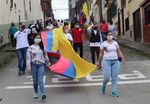WHY ARE PEOPLE PROTESTING IN COLOMBIA?
←
→
Page content transcription
If your browser does not render page correctly, please read the page content below
WHY ARE PEOPLE PROTESTING IN
COLOMBIA?
Protes,Structural Violence, and ESCER in Colombia
Since April 28, 2021, there have been multiple Agreement, were some of the reasons that
and massive social protests in hundreds of drove citizens to take to the streets.
cities and municipalities in Colombia to express
citizens’ widespread social discontent in the Likewise, the National Strike responds to some
face of the critical socioeconomic situation, the structural causes related to ongoing violations
illogical and inefficient measures taken by the of Economic, Social, Cultural, and
Colombian government in this regard, and non- Environmental Rights (ESCER). The failure to
compliance with peace commitments. fulfill these rights has been aggravated by the
pandemic and the deepening of the social and
While it is true that the regressive tax reform economic crisis that the COVID-19 health
proposal presented by the Ministry of Finance emergency has brought on. Below are some
[1] was the trigger that prompted citizens to figures and data on poverty, inequality, hunger,
take to the streets, other elements such as unemployment, health, and the particular
growing poverty, unemployment, inequality, situation of women in Colombia before and
racism, lack of educational opportunities for after the pandemic, as elements of analysis to
young people, the health reform, [2] the murder
THE SECRET understand the relationship between the failure
of social leaders and ex-combatants who signed to satisfy ESCER and the social outcry in the
BEHIND THIS TRAVEL
the Peace Agreement, as well as intentional country.
non-compliance with the Peace1. MONETARY POVERTY: establishes that States must ensure that all
people have access to sufficient food to be
According to the National Administrative protected from hunger and undernourishment.
Department of Statistics (DANE, 2021), 35.7% However, even before the pandemic, food
of the Colombian population was living in insecurity, undernourishment, and malnutrition
monetary poverty in 2019. In 2020, this figure were the reality of hundreds of households, a
increased to 42.5% (21 million people). This situation that has been aggravated by lockdown
means that there were 3.5 million more people measures, job losses, business failure, and the
living in poverty in 2020 than in 2019. [3] inability to access basic resources. [9]
Likewise, in 2020, records indicated that 15.1%
of Colombians were living in extreme poverty Even with the existence of regular and
(7.5 million people), [4] 2.78 million more than extraordinary food security programs at the
in 2019 [5]. national and territorial levels during the
pandemic, [10] the situation of hunger is
alarming. During the lockdown, hundreds of red
2. INEQUALITY: rags were hung on the windows of homes across
the country as a sign of hunger. In February
In 2019, the Economic Commission for Latin 2021, the DANE’s Social Pulse survey found
America and the Caribbean (ECLAC) noted that that 2.4 million households in the country live
Colombia is the second most unequal country in on less than three meals a day (1.6 million
Latin America, Brazil. [6] Likewise, the 2020 families who, at the beginning of the quarantine
report on the Regional Development Index for could eat three meals a day, can no longer do
Latin America (IDERE LATAM, for its acronym so). Of those 2.4 million households, 179,174
in Spanish) stated that Colombia is the country live on one meal a day and 23,701 are
with the greatest inequalities within its national sometimes unable to receive even one plate of
territory, which means that no other country in food a day.
Latin America has such large gaps between its
regions in terms of levels of development. [7] In
addition, inequality in Colombia increased 4. UNEMPLOYMENT:
during the pandemic. The country’s Gini
coefficient was 0.526 in 2019, and it reached
The unemployment rate in April 2019 was
0.544 in 2020. [8]
10.3%, equivalent to 2.5 million unemployed
people. [11] By April 2020, the unemployment
3. HUNGER: rate had increased to 19.8%, with 4 million
people unemployed and an especially high rate
among women, given that highly feminized jobs
The International Covenant on Economic,
(care work, domestic work, hairdressing) and
Social, and Cultural Rights (ICESCR) recognizes
sectors with high female participation (tourism,
the right to adequate food in Article 11 and
transport, trade) were the first to be affectedby the pandemic. In 2021, there was a slight regulatory agent, and the right to health
improvement in the unemployment rate (15.1%) becomes a commodity. [17]
with 3.6 million unemployed people. [12]
The pandemic exposed the fragility of the
One of the main motivations of the National health system. Lack of timely access to COVID-
Strike precisely has to do with the lack of job 19 diagnosis and medical care, misinformation
opportunities for young people. According to about vaccines, and the delay in vaccines'
the DANE, the youth unemployment rate was arrival and distribution, coupled with a
23.9% in the first quarter of 2021, with 1.6 shortage of intensive care units (ICUs)
million young people unemployed, 92,000 more nationally, are areas of great concern. Added
than in November 2019. [13] Meanwhile, rural
employment is declining; although the
agricultural sector is fundamental to the "THE PANDEMIC
country’s economy, the DANE recorded 4.6
million people employed in rural areas,
EXPOSED THE
compared to 4.1 million reported in May 2020. FRAGILITY OF THE
[14] HEALTH SYSTEM"
Finally, it should be noted that informality is
to this are the precarious conditions of health
growing. As of March 2021, informal
workers, reflected in the increase in working
employment had risen to 49% (DANE, 2021).
hours and workload and the decrease in wages.
This population does not have a fixed
These phenomena are only a small sample of
remuneration, labor guarantees, or social
critical structural conditions, such as the
protection (pension contributions and
following: more than 43% of health personnel
affiliation to Occupational Risk Administrators,
have a type of indirect labor relationship, that
known as ARLs for their acronym in Spanish, or
is, through third parties, which enables greater
public health insurance entities, known as EPSs
violation of labor rights; many institutions did
not provide biosafety-related PPE for staff; and
measures to increase workload or reduce wages
5. HEALTH: could not be addressed effectively. As of
October 2020, 229 health workers had already
died from COVID-19. [18]
In Colombia, the health system already
reflected deficiencies before the pandemic in
terms of the availability, quality, and
6. WOMEN:
accessibility of different services, as the
Committee on Economic, Social, and Cultural
Rights (CESCR) had found in its last review on There are 22.6 million women in Colombia,
Colombia. [15] The number of complaints and representing 51.2% of the country’s total
tutelas (a Colombian legal mechanism to population. [19] Despite being the majority,
protect fundamental rights) are high and women face a wide range of structural
increasing. There is no priority health care for inequalities, which are reflected in barriers and
vulnerable population, [16] and the insurance gaps in the workplace; in power and decision-
model established by Law 100 of 1993 handed making spaces; and in access to education,
over health service management to health health, and sexual and reproductive rights,
companies. The State thus disappears as a among others. [20]In the economic and labor domain, nearly 3 out CITAS BIBLIOGRAFICAS
of 10 Colombian women aged 15 and over have
no income of their own, as opposed to 1 in 10
[1] The “Sustainable Solidarity Law” tax reform bill
men. The unemployment rate in April 2021 was submitted by the national government to Congress
12.1% for men and 19.1% for women. Of the on April 15, 2021 aimed to raise approximately 23
456,000 people who came out of trillion Colombian pesos (approximately US$6.3
billion) through measures such as the following: the
unemployment, 410,000 are men and just collection of value-added tax (VAT) on basic
46,000 are women, meaning that for every 10 consumer products such as utilities (water,
men who obtained employment, only one electricity, and gas), funeral services, electronic
products such as computers (which had been
woman could do so. [21] In addition, women
previously exempt), and tolls within cities, among
receive 12.1% lower pay for their work than other regressive measures. See:
men. Unpaid domestic and care work (UDCW) is https://bit.ly/3iLDHxZ
mostly performed by women, who devote 78%
of their annual time to care work, while men
[2] Bill 010 of 2020 proposed a health reform that,
spend only 22% of their hours on these tasks. according to various academics, organizations, and
This disproportionate distribution decreases movements in the health sector, would deepen the
women’s time to exercise other rights, such as privatization of the health system and market
model and would not improve the conditions of
studying, working formally, or enjoying rest, health workers, access to health services, or the
self-care, and recreation. financial state of clinics and hospitals. To read the
bill, see: https://bit.ly/3zzxQ4T
Finally, the lockdown measures resulted in an
[3] It is estimated that more than 21 million people
increased risk of experiencing gender-based subsist on less than $331,688 COP per month
violence (GBV); between March 2020 and (approx. US$90).
February 2021, calls to hotlines to help with
[4] According to the DANE, Colombians who live on
these cases increased 84%. Feminicides have
less than $145,004 COP per month (approx.
also increased. According to the Attorney US$90).
General’s Office, 147 women were victims of
feminicide in 2020, although civil society [5] DANE, April 29, 2021. Comunicado de prensa
sobre pobreza monetaria Año 2020. Available at:
organizations estimate that there were 217 https://bit.ly/2U5fLve
victimis. [22]
[6] OECD et al. (2019). Latin American Economic
Outlook 2019: Development in transition. Available
at: https://bit.ly/3xP9h25
[7] Universidad de los Andes. May 2020. Covid-19.
Sus efectos de pobreza y desigualdad en Colombia.
Colombian Platform for Human Rights, Available at: https://bit.ly/3gw94v8
Democracy, and Development
[8] DANE, op. cit
(Plataforma Colombiana de Derechos Humanos,
Democracia y Desarrollo) [9] Chaverra, T. et al (2020). El hambre en tiempos
June 2021 de COVID-19: Exacerbación de un problema oculto.
Salutem Scientia Spiritus 2020; 6:174-180.
Available at: https://bit.ly/3zJdHJZ
[10] Dejusticia. (2020). Políticas, hambre y Covid-19. Del miedo a la acción. Available at: o communicate the Technical Secretary of the Platform,
https://bit.ly/2SB4zGy please contac us at plataformaco@gmail.com or the
following numbers:
[11] El Espectador, May 31, 2021, Tasa de desempleo en
Colombia se ubicó en 15,1 % en abril de 2021. Available Viva la Ciudadanía - Aura Rodríguez
at: https://bit.ly/3wESDC6 Secretaria técnica
aura.rodriguez@viva.org
[12] DANE, May 31, 2021, Comunicado de prensa Gran Tel: 3167405749
Encuesta Integrada de Hogares (GEIH) abril 2021.
Available at: https://bit.ly/3zxOCkV Vanessa Cárdenas
Profesional de apoyo
[13] La República, May 13, 2021, El desempleo juvenil se apoyoplataformadesc@gmail.com
ubicó en 23,9% y contó con 1,6 millones de personas en Tel:3153540997
marzo. Available at: https://bit.ly/3vBDn82
Paola Almonacid
[14] Morales, A. (2020). El desempleo: una pandemia que Apoyo administrativo
azota a Colombia. Universidad EAN. plataformaco@gmail.com
Available at: https://bit.ly/2TKBcSk Tel:3144249194
[15] PCDHDD. Resumen ejecutivo del informe alterno Sandra Gutiérrez
de la sociedad civil al VI informe del Estado colombiano Comunicaciones
al comité DESC. Available at: https://bit.ly/3gHwc8J comunicacionesPCDHDD@gmail.com
Tel:3183886892
[16] Defensoría del Pueblo. Informe Alterno al Sexto
Informe del Estado Colombiano ante el Comité de
Derechos Económicos, Sociales y Culturales 2010 Sigannos en redes sociales a través:
-2015. Available at: https://bit.ly/3zBvgvd
Facebook: PlataformaDesc
[17] Jiménez, W. (2009). El derecho a la salud. Una
búsqueda inacabada para la sociedad colombiana. Instragram: plataformadesc
Available at: https://bit.ly/3wF0QGq
Twitter: PlataformaDesc
[18] Cfr. Infobae. Los héroes que hemos perdido.
Personal de Salud fallecido por Covid-19 - Infobae.com Youtube: Plataforma Colombiana
[19] DANE, Censo Nacional de Población y Vivienda, https://ddhhcolombia.org.co/
2018.
plataformaco@gmail.com
[20] DANE; CPEM; UN WOMEN. (2020). Informe
Mujeres y hombres: brechas de género en Colombia. Cl. 54 #10-82, Bogotá/
Available at: https://bit.ly/3zu3uAK
[21] El Espectador, op. cit.
[22] United Nations Population Fund (UNFPA).
Comunicado Día Internacional de la Mujer 2021.
Available at: https://bit.ly/3wFiTMG
See: Sisma Mujer (2021). Boletín No. 25. Día
Internacional por los derechos de las mujeres. Available
at: https://bit.ly/2SdDucgYou can also read



























































